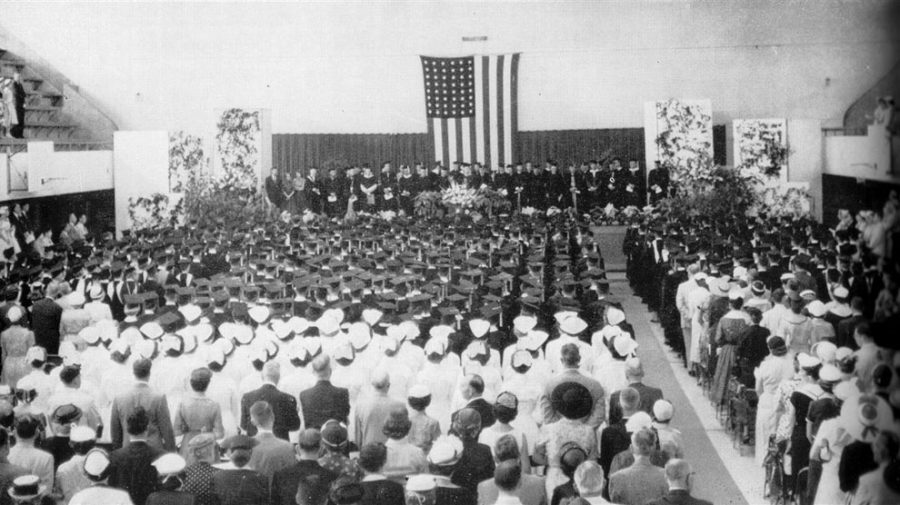The entire graduation process can be daunting for students, and the University of Alabama likes to focus on tradition when it comes to ceremonies.
In 1909, Arnold van Gennep coined the phrase “rite of passage,” which included the steps of separation from society, transition, and reincorporation into society.
Michael George, University Registrar, said all commencement ceremonies have been hosted in Coleman Coliseum.
“There was one exception,” George said. “Spring commencement in 2005 was held in Bryant-Denny Stadium due to the renovation of the coliseum. It is the tradition of the University to keep the focus on the candidates at commencement.”
The University regulates that only 1,078 seats or less can be on the floor of the coliseum. Because of the increasing size of graduating classes, the University has created two ceremonies in the spring for different colleges.
Barry Mason, dean of the business school, has been on faculty at the University since 1967. He has attended graduation ceremonies for 30 years, with three ceremonies a year. Having attended more than 90 commencements, he has seen the tradition.
“[Graduation] is more formal,” Mason said, “therefore, laden with greater significance than on other campuses in which the attire is quite different that students are prone to shenanigans of one kind or another. It is a formal occasion, but it is festive. I think that is part of the tradition here and part of the Deep South tradition.”
George explained how the commencement typically worked at the University, and how it originated.
“When ceremonies are associated, they usually include a procession of the academic staff and candidates,” George said. “Graduation at the college and university level occurs when the presiding officer, typically the president of the University, confers degrees upon candidates, either individually or en masse, even if graduates physically receive their diploma later.”
The Baccalaureate Ceremony is typically the beginning of the rite of passage. The first ceremony was said to have occurred in 1432 at Oxford University. At that time, each student was required to deliver a sermon in Latin as part of his or her academic applications, George said.
“Graduations are now faster, and we no longer have a speaker who will talk for fifteen minutes or so,” Mason said. “I think that tradition is important, because the University prides itself on many traditions in the football arena and elsewhere. Parents and grandparents can come back to campus, see the next generation and have basically the same experience. It’s a part of the bonding process that can occur between the generations.” Typically, ceremonies at the University begin with speeches from faculty or special speakers. After, students are then called one by one during a rendition of “Pomp and Circumstance,” a song composed by Sir Edward Elgar and first performed in 1901 in Liverpool, England. The candidates receive their diploma and a handshake, and flip the tassel on their hat to the other side.
Attire is also something that has passed from one generation to the next, and change is not common at the University.
“The caps and gowns worn by graduates, faculty and platform party are based on the academic costumes used in universities of the fourteenth or fifteenth centuries, particularly at Oxford and Cambridge,” George said.
“These academic costumes, sometimes referred to as academic regalia, are based on the early European universities’ costumes, and these have been used in the United States since colonial times.”
Although black is the most common robe color, people now wear different colored sashes and medals denoting different aspects and schools of the University. Education doctors wear light blue, musical arts doctors wear pink, nursing doctors wear salmon, philosophy doctors wear dark blue, and juris doctors wear purple.
Graduates of different colleges also wear distinguishing colors: white for Arts and Sciences, tan for Commerce and Business Administration, red for Communication, light blue for Education, orange for Engineering, maroon for Human Environmental Science, lemon-yellow or brown for Library and Information Studies, brown for Nursing and yellow for social work.
“What we call today a ‘cap,’ which is worn by students and faculty in some cases, used to be called a ‘hood,’” George said. “The ‘hood’ is believed to date back to the Celtic groups. Today, the hood or cap is used to identify the student’s academic institution and degree. The tassel is used to signify the student’s academic achievement within the academic structure.”
The candidates for doctor of education, musical arts, nursing and philosophy degrees will receive their diplomas at the actual commencement. All other graduates will receive the diploma in the mail about a month after the ceremony.
Mason believes it is important for students to attend the graduation ceremony and try to fit it into their busy schedules.
“I think in [students’] later years, they will look back and regret that they did not [attend],” Mason said. “The ceremony is a turning point in their lives from their role as students going into the world of work as professionals. In the short term, of course, it is less important to them perhaps. Life is a series of passages, and this is just another passage.”









